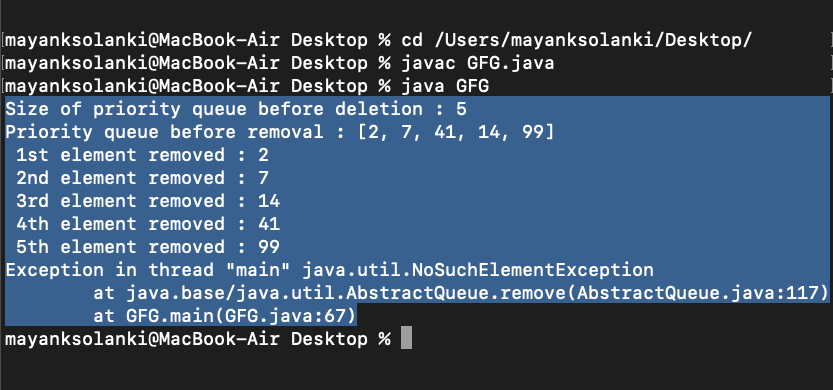Java PriorityQueue remove()方法
java.util包中 PriorityQueue类 的remove()方法 用于从PriorityQueue中删除一个特定的元素。 我们都知道,元素在进入优先级队列时是不排序的,但我们都知道,当从优先级队列中取出元素时,元素总是被排序的,这是优先级队列的一个特征。在这里,数据类型的元素的默认优先级排序定义如下。
- 整数 :最小的元素排在前面(当只处理正数的时候
- 字符串 : 按字母顺序排列
注意: 在创建这个类的实例时,我们也可以插入一个比较器,告诉我们优先级应该如何定义。
语法
PriorityQueue<String> = new PriorityQueue<String>(ComparatorHere);
语法: 删除方法
Priority_Queue.remove(Object O)
参数: 参数 O 是PriorityQueue的类型,指定要从PriorityQueue中删除的元素。
返回值: 如果指定的元素存在于队列中,该方法返回True,否则返回False。
例子1
// Java Program to Illustrate remove() Method
// in PriorityQueue
// Where Elements are of String Type
// Importing all utility classes
import java.util.*;
// Main class
// PriorityQueueDemo
public class GFG {
// Main driver method
public static void main(String args[])
{
// Creating an empty PriorityQueue
// where elements are of string type
PriorityQueue<String> queue
= new PriorityQueue<String>();
// Adding elements into the Queue
// using add() method
queue.add("Welcome");
queue.add("To");
queue.add("Geeks");
queue.add("For");
queue.add("Geeks");
// Printing the elements of PriorityQueue
System.out.println("Initial PriorityQueue: "
+ queue);
// Removing elements from PriorityQueue
// using remove() method
queue.remove("Geeks");
queue.remove("For");
queue.remove("Welcome");
// Displaying the PriorityQueue
// after removal of element
System.out.println("PriorityQueue after removing "
+ "elements: " + queue);
}
}
输出
Initial PriorityQueue: [For, Geeks, To, Welcome, Geeks]
PriorityQueue after removing elements: [Geeks, To]
例2
// Java Program to Illustrate remove() Method
// of PriorityQueue class
// Where Elements are of Integer type
// Importing required classes
import java.util.*;
// Main class
// PriorityQueueDemo
public class GFG {
// Main driver method
public static void main(String args[])
{
// Creating an empty PriorityQueue by
// creating an object of integer type
PriorityQueue<Integer> queue
= new PriorityQueue<Integer>();
// Adding custom input elements
// using add() method
queue.add(10);
queue.add(15);
queue.add(30);
queue.add(20);
queue.add(5);
// Displaying the PriorityQueue
System.out.println("Initial PriorityQueue: "
+ queue);
// Removing elements from the PriorityQueue
// using remove() method
queue.remove(30);
queue.remove(5);
// Displaying the PriorityQueue elements
// after removal
System.out.println("PriorityQueue after removing "
+ "elements: " + queue);
}
}
输出
Initial PriorityQueue: [5, 10, 30, 20, 15]
PriorityQueue after removing elements: [10, 20, 15]
Geek,你有没有想过,如果对remove()方法的调用超过了队列中存在的元素,会发生什么?在这种情况下,它将继续删除原有的元素,此后它将找不到任何元素可以优先删除,所以它将 抛出一个异常 ,如下所示。
注: 该类实现了AbstractQueueInterface。
例子
// Java Program to illustrate remove() Method
// in PriorityQueue
// Where Exception is encountered
// Importing required classes
import java.io.*;
import java.util.PriorityQueue;
// Main class
// PriorityQueueException
class GFG {
// Main driver method
public static void main(String[] args)
{
// Creating an empty PriorityQueue
PriorityQueue<Integer> pq
= new PriorityQueue<Integer>();
// Note: Elements are inserted in unsorted order in
// priority queue but after removal of elements
// queue is always sorted.
// Adding elements in above queue
// using add() method
pq.add(2);
pq.add(14);
pq.add(41);
pq.add(7);
pq.add(99);
// Elements in queue are unsorted by far
// Getting size of above queue before deletion
// of any element using size() method
System.out.println(
"Size of priority queue before deletion : "
+ pq.size());
// Printing all elements of above queue
System.out.println(
"Priority queue before removal : " + pq);
// Calling remove() method over priority queue
// in which there were 5 elements
// Here calling remove() method say be it 2 times
// So 2 top priority elements will be removed
System.out.println(" 1st element removed : "
+ pq.remove());
System.out.println(" 2nd element removed : "
+ pq.remove());
System.out.println(" 3rd element removed : "
+ pq.remove());
System.out.println(" 4th element removed : "
+ pq.remove());
System.out.println(" 5th element removed : "
+ pq.remove());
// By now queue is empty and if now we made further
// remove() call it will throw exception for this
System.out.println(" 6th element removed : "
+ pq.remove());
// As we know smaller the integer bigger the
// priority been set by default comparator of this
// class
// Note: Now the element is always returned sorted
// from a priority queue is a trait of this class
// Printing the queue after removal of priority
// elements
System.out.println(
"Priority queue after removal as follows: "
+ pq);
}
}
输出

输出解释。
它展示了队列中没有更多的元素了,因为队列现在是空的,所以它是否抛出NoSuchElementException。
 极客教程
极客教程